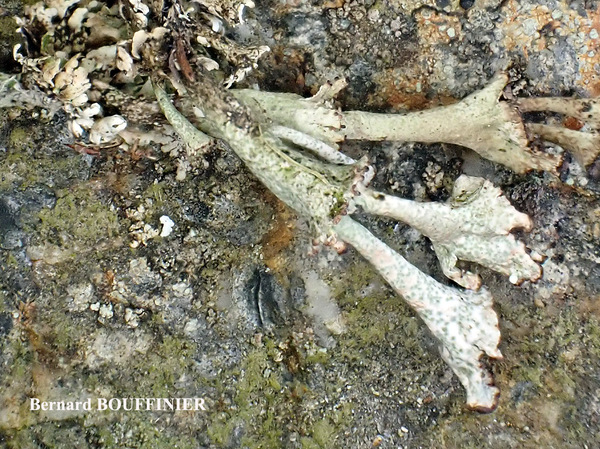Cladonia pulvinata (Sandst.) Herk & Aptroot
Bibl. Lichenol., 86: 200, 2003. Basionym: Cladonia verticillata f. pulvinata Sandst. - Cladon. Exs. nr. 233, 1918.
Synonyms:
Distribution: N - Lomb (Gheza 2018, 2019, Gheza & al. 2018, 2022, Ravera & al. 2019a), Piem (Gheza & al. 2018, Gheza 2020).
Description: Primary thallus squamulose, persistent and forming cushions, the squamules 4-8 mm long, 1-2 mm wide, upcurled and deeply incised, brownish green above, yellowish white beneath, the base somewhat darker and very finely arachnoid. Podetia not always present, stunted, hollow inside, dark brownish green, up to 3(-5) cm tall, terminated by a up to 4 mm wide cup which usually proliferates from the center (1-2 tiers), the surface areolate-corticate, esorediate, the base strongly melanotic. Apothecia rare, brown. Asci 8-spored, clavate, thickened at apex, with a K/I+ blue tholus and a K/I+ strongly blue outer gelatinous sheath, Cladonia-type. Ascospores 1-celled, hyaline, ellipsoid. Pycnidia dark, pyriform, with a colourless jelly, developing at the margins of cups. Conidia hyaline, curved. Photobiont chlorococcoid. Spot tests: K-, C-, KC-, P+ bright yellow or rarely P+ orange-red, UV-. Chemistry: psoromic and conpsoromic acids, rarely with additional fumarprotocetraric acid.Note: a mainly western European species ranging from Spain to Norway, found on acid soil, often in Calluna-heaths.
Growth form: Squamulose
Substrata: soil, terricolous mosses, and plant debris
Photobiont: green algae other than Trentepohlia
Reproductive strategy: mainly asexual, by thallus fragmentation
Most common in areas with a humid-warm climate (e.g. most of Tyrrenian Italy)
Commonnes-rarity: (info)
Alpine belt: absent
Subalpine belt: absent
Oromediterranean belt: absent
Montane belt: extremely rare
Submediterranean belt: very rare
Padanian area: absent
Humid submediterranean belt: absent
Humid mediterranean belt: absent
Dry mediterranean belt: absent

Predictive model
Herbarium samples
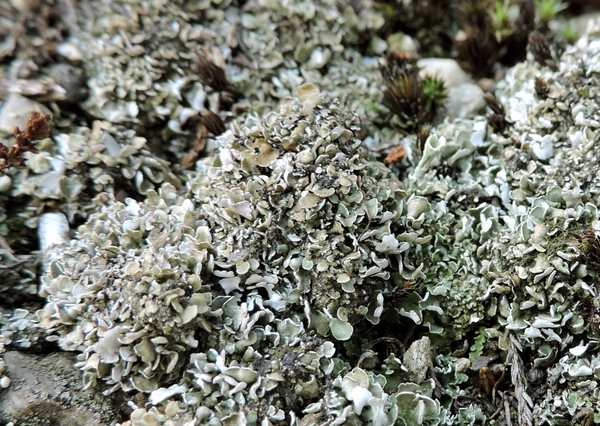
Gabriele Gheza
Italy, Lombardia, Brughiera della Promessa, Lonate Pozzolo (Varese), brughiera a Calluna, 186 m
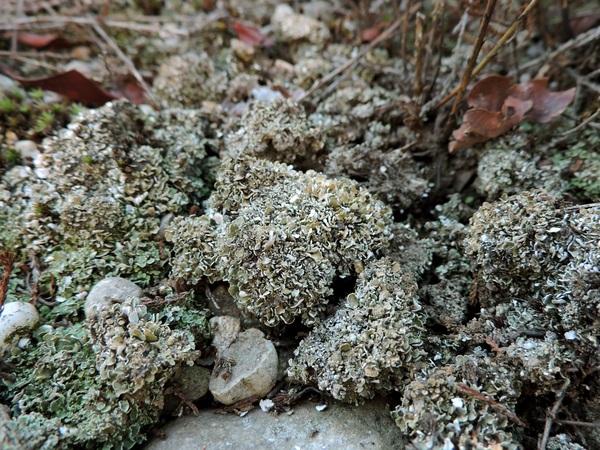
Gabriele Gheza
Italy, Lombardy, Varese, Brughiera della Promessa, Lonate Pozzolo (Varese), brughiera a Calluna, 186 m s.l.m.,
09.2017
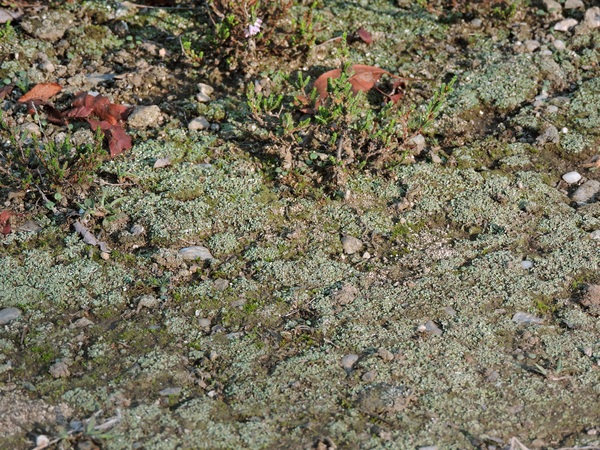
Gabriele Gheza
Italy, Lombardy, Varese, Brughiera della Promessa, Lonate Pozzolo (Varese), brughiera a Calluna, 186 m s.l.m.,
09.2017
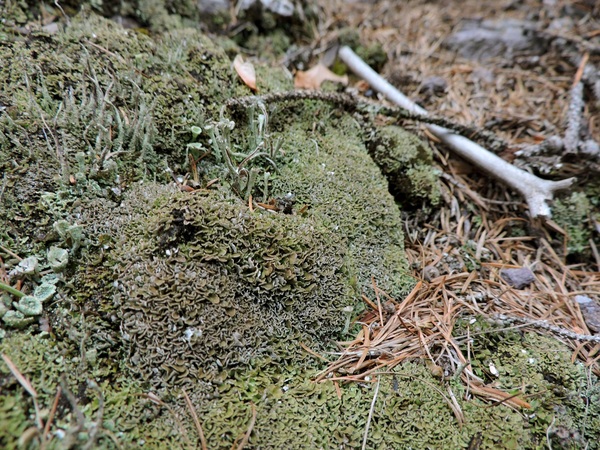
Gabriele Gheza
Italy, Lombardy, Bergamo, Vilminore di Scalve (Bergamo), radura in bosco di conifere, 1470 m s.l.m.
04.2018
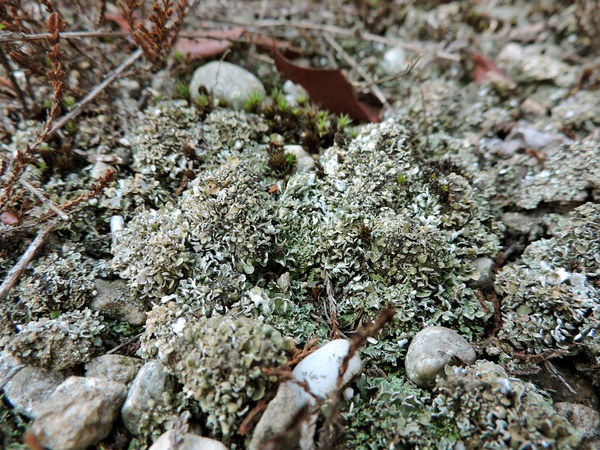
Gabriele Gheza
Italy, Lombardy, Varese, Brughiera della Promessa, Lonate Pozzolo (Varese), brughiera a Calluna, 186 m s.l.m.,
09.2017

Gabriele Gheza
Italy, Lombardy, Bergamo, Vilminore di Scalve (Bergamo), radura in bosco di conifere, 1470 m s.l.m.
04.2018
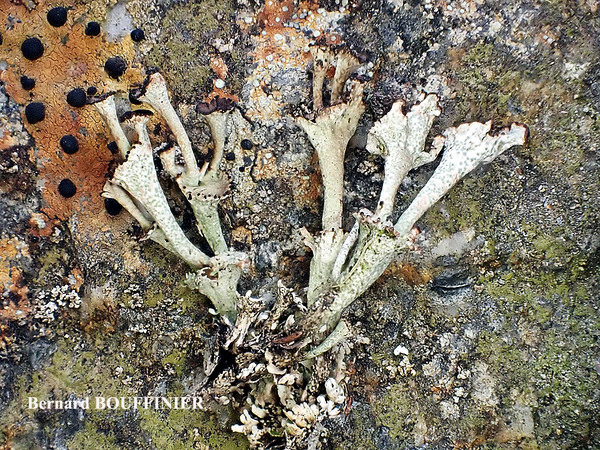
Bernard Bouffinier - Source: http://www.lichensmaritimes.org/index.php?task=fiche&lichen=1354&lang=en
France, Commana
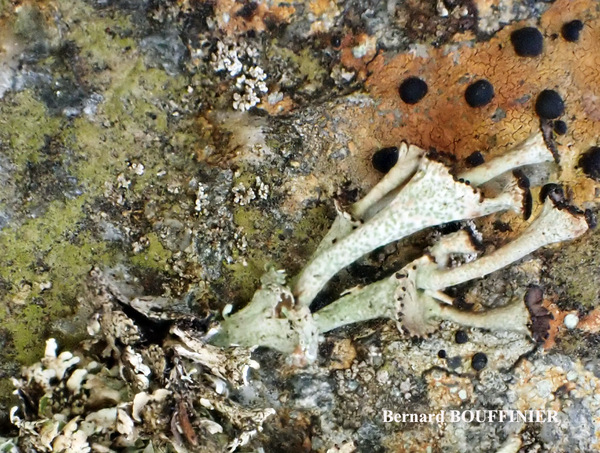
Bernard Bouffinier - Source: http://www.lichensmaritimes.org/index.php?task=fiche&lichen=1354&lang=en
France, Commana
Growth form: Squamulose
Substrata: soil, terricolous mosses, and plant debris
Photobiont: green algae other than Trentepohlia
Reproductive strategy: mainly asexual, by thallus fragmentation
Most common in areas with a humid-warm climate (e.g. most of Tyrrenian Italy)
Commonnes-rarity: (info)
Alpine belt: absent
Subalpine belt: absent
Oromediterranean belt: absent
Montane belt: extremely rare
Submediterranean belt: very rare
Padanian area: absent
Humid submediterranean belt: absent
Humid mediterranean belt: absent
Dry mediterranean belt: absent

Predictive model
| Herbarium samples |

Gabriele Gheza
Italy, Lombardia, Brughiera della Promessa, Lonate Pozzolo (Varese), brughiera a Calluna, 186 m

Gabriele Gheza
Italy, Lombardy, Varese, Brughiera della Promessa, Lonate Pozzolo (Varese), brughiera a Calluna, 186 m s.l.m.,
09.2017

Gabriele Gheza
Italy, Lombardy, Varese, Brughiera della Promessa, Lonate Pozzolo (Varese), brughiera a Calluna, 186 m s.l.m.,
09.2017

Gabriele Gheza
Italy, Lombardy, Bergamo, Vilminore di Scalve (Bergamo), radura in bosco di conifere, 1470 m s.l.m.
04.2018

Gabriele Gheza
Italy, Lombardy, Varese, Brughiera della Promessa, Lonate Pozzolo (Varese), brughiera a Calluna, 186 m s.l.m.,
09.2017

Gabriele Gheza
Italy, Lombardy, Bergamo, Vilminore di Scalve (Bergamo), radura in bosco di conifere, 1470 m s.l.m.
04.2018

Bernard Bouffinier - Source: http://www.lichensmaritimes.org/index.php?task=fiche&lichen=1354&lang=en
France, Commana

 INDEX FUNGORUM
INDEX FUNGORUM
 GBIF
GBIF
 DOLICHENS
DOLICHENS
